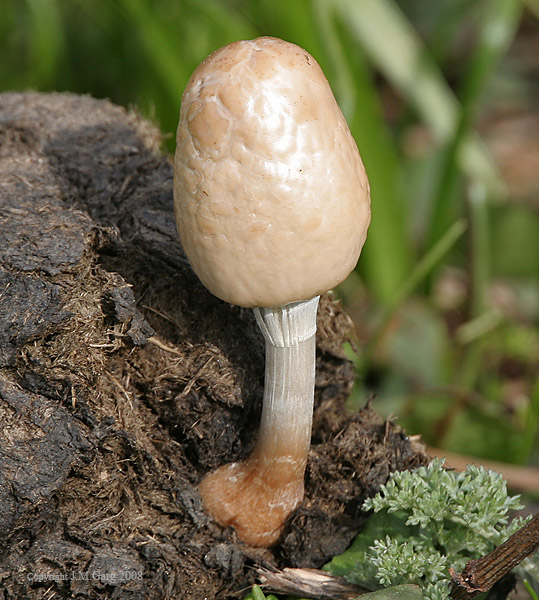Panaeolus semiovatus (Sowerby) S. Lundell & Nannf., 1938 (syn: Agaricus ciliaris Bolton, 1788; Agaricus egregius Massee, 1885; Agaricus nutans Fr., 1821; Agaricus phalenarum Fr., 1838; Agaricus semiovatus Sowerby, 1798; Agaricus separatus L., 1753; Anellaria fimiputris sensu auct. mult. (misapplied name); Anellaria phalenarum (Fr.) M. M. Moser, 1967; Anellaria semiovata (Sowerby) A. Pearson & Dennis, 1948; Anellaria separata (L.) P. Karst., 1879 …; Chalymmota phalenarum (Fr.) P. Karst., 1879; Coprinarius phalenarum (Fr.) Quél., 1886; Coprinarius semiovatus (Sowerby) Trog, 1832; Coprinarius separatus (L.) Quél., 1886; Coprinus ciliaris (Bolton) Gray, 1821; Coprinus ciliatus (Bolton) Gray, 1821; Coprinus semiovatus (Sowerby) Gray, 1821; Panaeolus antillarum sensu Watling & Gregory (BFF5)(misapplied name); Panaeolus egregius (Massee) Sacc., 1887; Panaeolus fimiputris sensu auct. mult. (misapplied name); Panaeolus phalenarum (Fr.) Quél., 1872 ..; Panaeolus semiovatus f. exannulatus A. Pearson …..; Panaeolus separatus (L.) Quél., 1877; Pholiota separata (L.) P. Kumm., 1871; Strophaneolus phalenarum (Fr.) Bon, 1970; Stropharia separata (L.) J. E. Lange, 1923; Stropharia separata var. minor J. E. Lange, 1923; Stropharia separata var. separata (L.) J. E. Lange, 1923);
Panaeolus semiovatus submission : 3 posts by 3 authors. Attachments (3) – around 600 kb each. Here’s one new addition to site. Panaeolus semiovatus Shiny mottlegill / Egghead mottlegill Family – Bolbitiaceae Habitat – Found growing on horse dung. Photographed at Rohtang Pass, Himachal Pradesh Dated – 12 August 2018 Thanks, …, for the beautiful addition. Yes, appears close as per images at http://www.mykoweb.com/CAF/species/Panaeolus_semiovatus.html Mushroom for Id 100909Jm2 : Attachments (1). 6 posts by 3 authors. During Sar Pass Trek in Himachal on 11/5/07. I have only this picture. a very nice foto indeed, but not enough info (underside, stem etc) to ID. Still will look in my books, when have a bit more time! As I can see this mushroom is growing on dung so is coprophilous. This appears to be species of Coprinus. I will try if I can identify the species from the pic. Yes it Coprinus belong to Coprinaceae family, black sporeprint, very delicate dung fungus. …, although here also gills images are missing but fortunately annulus is visible and can be seen growing on dung so growing habit is known. So this is most likely Panaeolus semiovatus (Bolbitiaceae) I am saying this on basis of my experience also as this species is found growing on horse dung, i have posted its images earlier from Rohtang Pass.
References: |
Panaeolus semiovatus
Updated on December 24, 2024




